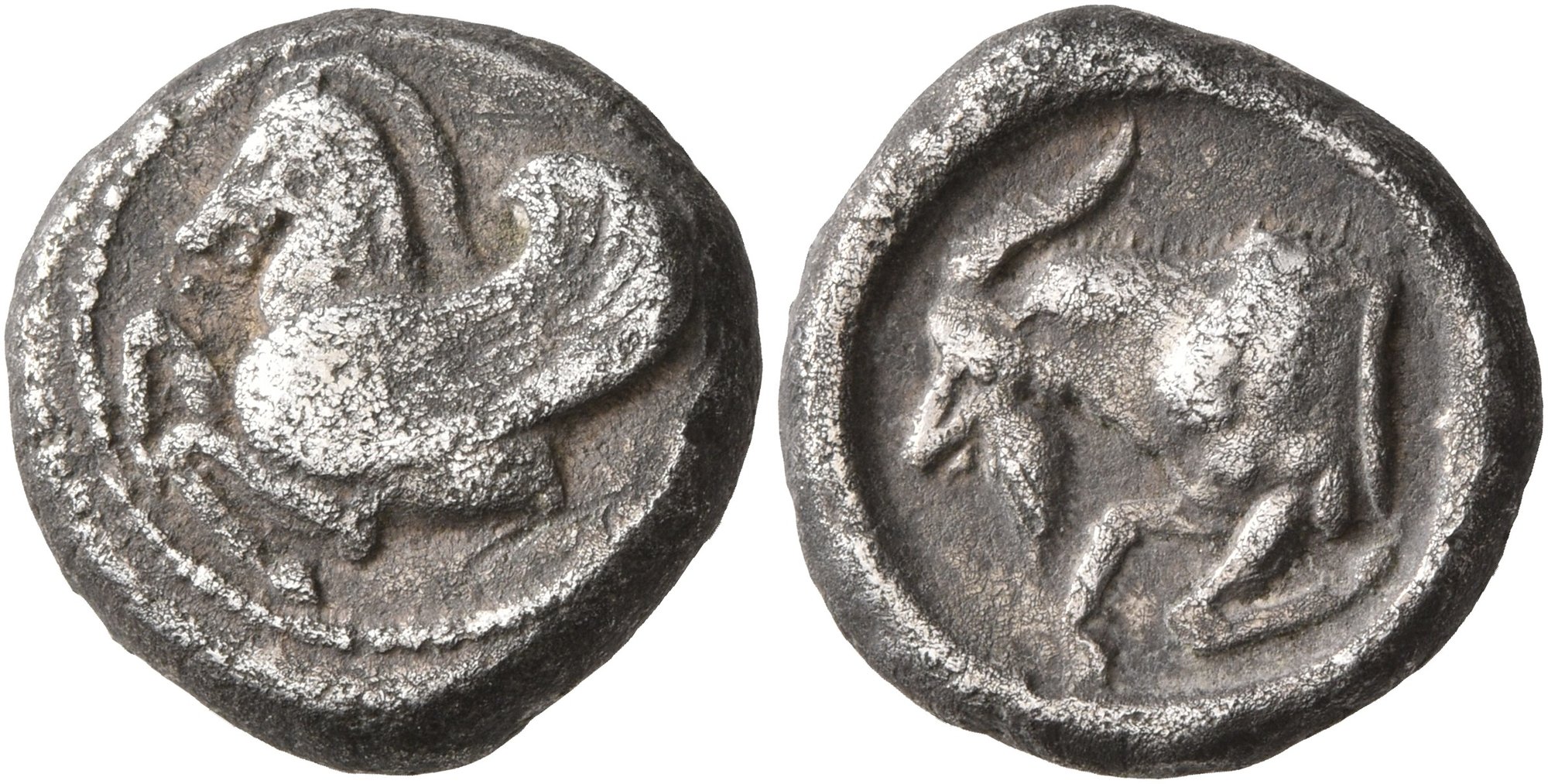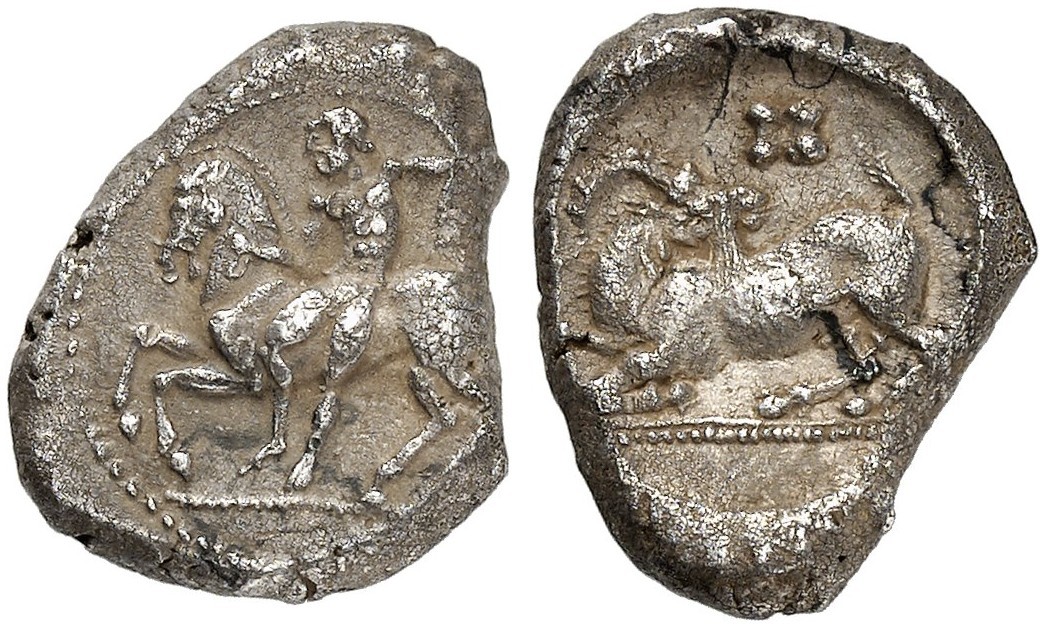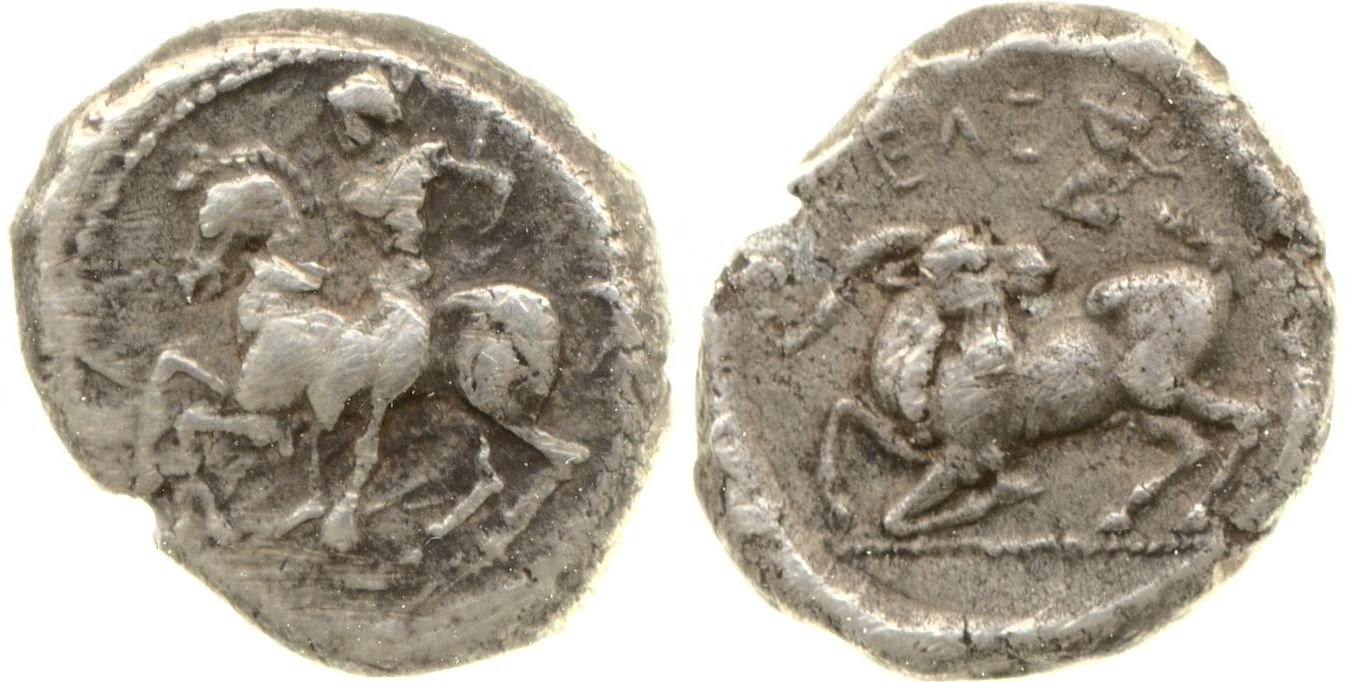Forepart of Pegasus, forepart of goat Horse left, goat left Horse right, goat left Horse right, goat right
Forepart of Pegasus, forepart of goat
| Type 4.1 | |
| Denomination: | AR Third Stater |
| Obverse: | Forepart of Pegasus left; dotted border. |
| Reverse: | Forepart of goat kneeling to left within circular incuse. |
| References: | Leu Numismatik, Web Auction 9 (7 September 2019), Lot 422 (acsearch.info URL) |
| Connection: | Type 5.1 (obols, the same design) |
| Credit: | Leu Numismatik (see the reference above) |
| Remark: | The assignment to Kelenderis is based on the use of the forepart of Pegasus on later small denominations of Kelenderis and on the analogous reverse design of the staters of Group 1. |
Horse left, goat left
| Type 4.2 | |
| Denomination: | AR Third Stater |
| Obverse: | Youthful nude rider, holding reins in right hand and whip in left, dismounting from horse rearing to left on dotted exergual line; dotted border. |
| Reverse: | Male goat kneeling to left on double solid and dotted exergual line, head turned back to right; above goat, astragalos; all within circular incuse. |
| References: | SNG France 2, 59; Imhoof-Blumer 1890, p. 182 (706), 552; several specimens on the market, e.g. Gorny & Mosch Giessener Münzhandlung, Auction 229 (10 March 2015), Lot 1391 (acsearch.info URL) |
| Connection: | Type 2.2 (staters, the same design) |
| Credit: | Gorny & Mosch Giessener Münzhandlung (see the reference above) |
| Type 4.3 | |
| Denomination: | AR Third Stater |
| Obverse: | Youthful nude rider, holding reins in right hand and whip in left, dismounting from horse rearing to left; before horse, round shield; in exergue, dolphin left; dotted border. | |
| Reverse: | Male goat kneeling to left on solid exergual line, head turned back to right; above goat, boxed form of letter heta; all within circular incuse. | |
| References: | BMC 21, p. 53, 12 = The British Museum (London), museum number 1893,1004.20; SNG France 2, 60 | |
| Connection: | Types 2.5 (staters – dolphin, round shield and boxed form of heta) and 5.5 (obols – round shield and boxed form of heta) | |
| Credit: | The Bibliothèque Nationale de France, Gallica, Identifier: ark:/12148/btv1b8473336k | |
| Remarks: | (1) |
BMC 21 describes the object in front of the horse as pellet in circle, but the possibility that it is a round shield is admitted in the attached footnote. SNG France 2 does not specify this object. Herodotus (The Histories, 7.91) mentions the round shields of the Cilicians: The Cilicians furnished a hundred ships. They also wore on their heads their native helmets, carried bucklers of raw oxhide for shields, and were clad in woollen tunics; each had two javelins and a sword very close in style to the knives of Egypt. Small round equestrian shields held by dismounting riders can be seen on nomoi of Tarentum: Vlasto, 297–312 (c. 430–380 BC), 389–395 (c. 380–345 BC), 428–442 and 497 (c. 380–345 BC), 698–703 (c. 302–231 BC). |
| (2) | The dolphin is a symbol of Poseidon—a natural choice for a port city like Kelenderis. However, here the dolphin is placed under the horse, which likely refers to Poseidon Hippios (Ίππιος, i.e. ‘of Horses’), thus to Poseidon as the creator of horses and protector of horse racing. | |
| (3) | The symbol on the reverse corresponds to the boxed form of the letter heta (the Greek form of the Phoenician letter heth). See Jeffery 1961, p. 28, and Table of Letters at the end of the appendix part of the book (without page numbers). | |
| Type 4.4 | |
| Denomination: | AR Third Stater |
| Obverse: | Youthful nude rider, holding reins in right hand and whip in left, dismounting from horse rearing to left on dotted or solid exergual line; dotted border. | |
| Reverse: | Male goat kneeling to left on solid or dotted exergual line, head turned back to right; all within circular incuse. | |
| Variants: | a. | rev.: above goat, ivy branch oriented to right |
| b. | rev.: above goat, forked ivy branch oriented to left | |
| c. | rev.: above goat, ivy branch oriented to left | |
| References: | a. | Classical Numismatic Group, Electronic Auction 471 (1 July 2020), Lot 80 (acsearch.info URL) |
| b. | Several specimens on the market, e.g. Classical Numismatic Group, Auction 99 (13 May 2015), Lot 310 (acsearch.info URL) | |
| c. | SNG France 2, 61; The British Museum (London), museum number 1922,0425.70; Forrer/Weber 3, 7517 | |
| Connection: | Type 2.3 (staters, similar design with an ivy branch but with the ethnic in the obverse exergue) | |
| Credit (see the references above): | ||
| a. | Classical Numismatic Group | |
| b. | Classical Numismatic Group | |
| c. | The British Museum | |
| Type 4.5 | |
| Denomination: | AR Third Stater |
| Obverse: | Youthful nude rider, holding reins in right hand and whip in left, dismounting from horse rearing to left on dotted exergual line; in exergue, KEΛ (retrograde); dotted border. |
| Reverse: | Male goat kneeling to left on dotted exergual line, head turned back to right; above goat, KEΛ; all within circular incuse. |
| References: | Specimen 1: Gerhard Hirsch Nachfolger, Auction 267 (5 May 2010), Lot 338 (acsearch.info URL); Specimen 2: Roma Numismatics Limited, E-Sale 119 (24 April 2024), Lot 791 (acsearch.info URL) |
| Die links: | Type 4.6a (reverse) |
| Credit: | Specimen 1: Gerhard Hirsch Nachfolger (see the reference above); Specimen 2: Roma Numismatics Limited (see the reference above) |
| Remark: | The city ethnic on both the obverse and reverse is quite exceptional. Photographs of two specimens are presented here because, although both coins are struck from the same dies, the ethnic on the obverse is clearly legible on Specimen 1, while the legend on the reverse is visible on Specimen 2. The same reverse die was used for the listed coin of Type 4.6a and it is interesting to note that both coins are struck on flans that bear cut-off marks from a larger silver flan. |
| Type 4.6 | |
| Denomination: | AR Third Stater |
| Obverse: | Youthful nude rider, holding reins in right hand and whip in left, dismounting from horse rearing to left on dotted or solid exergual line; dotted border. | |
| Reverse: | Male goat kneeling to left on dotted or solid exergual line, head turned back to right; all within circular incuse. | |
| Variants: | a. | rev.: above goat, KEΛ |
| b. | rev.: above goat, KEΛE and two ivy leafs | |
| c. | rev.: above goat, KEΛEN | |
| References: | a. | Numismatik Naumann, Auction 55 (2 July 2017), Lot 360 (acsearch.info URL) |
| b. | SNG von Aulock, 5634 = The British Museum (London), museum number 1979,0101.967 | |
| c. | SNG von Aulock, 5633 | |
| Die links: | Variant 4.6a — Type 4.5 (reverse) | |
| Connection: | Type 2.6 (staters, similar style) | |
| Credit (see the references above): | ||
| a. | Numismatik Naumann | |
| b. | The British Museum | |
| Type 4.7 | |
| Denomination: | AR Third Stater |
| Obverse: | Youthful nude rider, holding reins in right hand and whip in left, dismounting from horse rearing to left on dotted or solid exergual line. | |
| Reverse: | Forepart of goat kneeling to left on dotted or solid exergual line, head turned back to right; all within circular incuse. | |
| Variants: | a. | obv.: behind forelegs of the horse under the rider’s feet, letter Λ; dotted exergual line; dotted border rev.: above goat, KEΛEN; dotted exergual line |
| b. | obv.: in front of hind legs of the horse, letter Λ; solid exergual line rev.: above goat, KEΛ; solid exergual line |
|
| References: | a. | Coll. P. Veselý, KEL-AR-18 |
| References: | b. | Coll. P. Veselý, KEL-AR-20 |
| Credit (see the references above): | ||
| a. | P. Veselý | |
| b. | P. Veselý | |
| Type 4.8 | |
| Denomination: | AR Third Stater |
| Obverse: | Youthful nude rider, holding reins in right hand and whip in left, dismounting from horse rearing to left on solid exergual line; dotted border. | |
| Reverse: | Forepart of goat kneeling to left on solid or dotted exergual line, head turned back to right; all within circular incuse. | |
| Variants: | a. | obv.: behind forelegs of the horse, letter Π; rev.: above goat, KEΛEN |
| b. | obv.: in front of hind legs of the horse, letter Π; rev.: above goat, KEΛ |
|
| c. | obv.: below whip, letter Π; rev.: above goat, KEΛ |
|
| References: | a. | SNG France 2, 57 |
| b. | Numismatik Naumann, Auction 92 (2 August 2020), Lot 327 (acsearch.info URL); Classical Numismatic Group, Electronic Auction 311 (25 September 2013), Lot 802 (acsearch.info URL) | |
| c. | SNG France 2, 58; Fritz Rudolf Künker GmbH & Co. KG, Auction 136 (10 March 2008), Lot 681 (acsearch.info URL) | |
| Connection: | Types 2.4 (staters, Π behind the horse’s front legs), 2.10 (staters, letter resembling Π behind the horse’s front legs) and 2.11 (staters, Π in front of the horse’s hind legs) | |
| Credit (see the references above): | ||
| a. | The Bibliothèque Nationale de France, Gallica, Identifier: ark:/12148/btv1b84733429 | |
| b. | Numismatik Naumann | |
| c. | Fritz Rudolf Künker GmbH & Co. KG | |
Horse right, goat left
| Type 4.9 | |
| Denomination: | AR Third Stater |
| Obverse: | Youthful nude rider, holding reins in left hand and whip in right, dismounting from horse rearing to right on solid exergual line; dotted border. | |
| Reverse: | Male goat kneeling to left on dotted exergual line, head turned back to right; all in circular incuse. | |
| Variants: | a. | rev.: above goat, KEΛEN |
| b. | rev.: above goat and on the right, KEΛE–N | |
| References: | a. | Coll. P. Veselý, KEL-AR-17 |
| b. | Gorny & Mosch Giessener Münzhandlung, Auction 208 (6 October 2012), Lot 1603 (acsearch.info URL) | |
| Credit (see the references above): | ||
| a. | P. Veselý | |
| b. | Gorny & Mosch Giessener Münzhandlung | |
| Remark: | The cited specimen of variant b is listed in the auction catalogue as a tetrobol, but its weight is given as 10.71 g, which corresponds to a stater. It cannot therefore be ruled out that it may be a variant of type 3.2. | |
Horse right, goat right
| Type 4.10 | |
| Denomination: | AR Third Stater |
| Obverse: | Youthful nude rider, holding reins in left hand and whip in right, dismounting from horse rearing to right on dotted exergual line; dotted border. |
| Reverse: | Male goat kneeling to right on dotted exergual line, head turned back to right; above goat, KEΛEN. |
| References: | Aegean Numismatics (Mentor, Ohio, USA), Fixed Price List (accessed 18 February 2024). |
| Credit: | Aegean Numismatics (see the reference above; the background has been removed from the original image) |
16 July 2021 – 13 October 2025


















